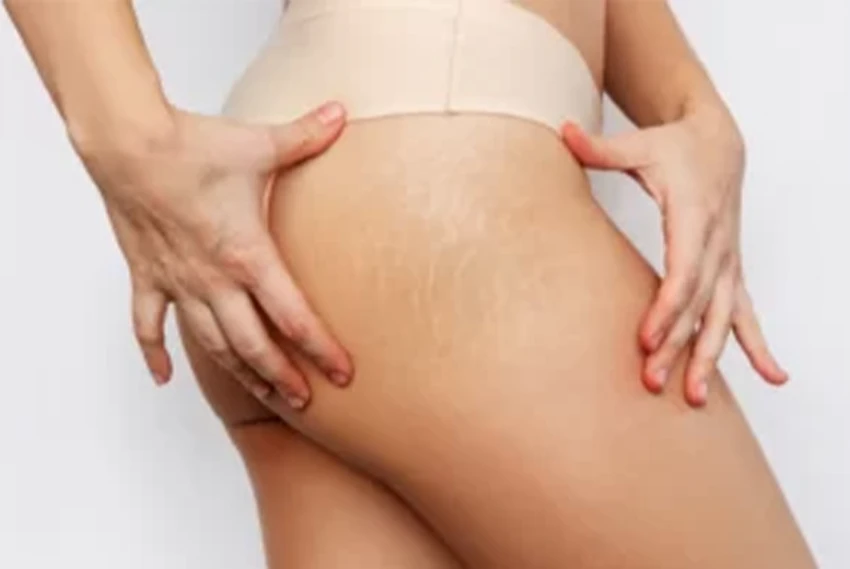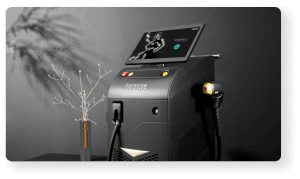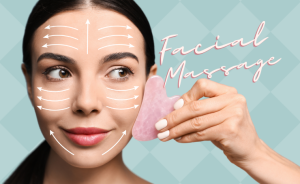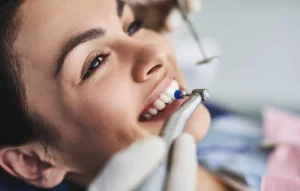Stretch marks are one of the skin problems that usually occur after sudden weight gain or weight loss, pregnancy, or hormonal changes in the body. These cracks are formed in the form of colorful lines on the skin and are usually seen on the abdomen, thighs, arms, chest and thighs.
These cracks are caused due to the reduction of skin elasticity and as a result of stretching caused by the mentioned changes in the body. Although this problem does not pose a risk to one’s health, it may be considered a cosmetic problem and some people may feel frustrated and uncomfortable with the appearance of their skin.
Treatment of stretch marks is usually done using creams, oils, laser and other medical methods. However, the most important way to prevent stretch marks is to maintain a healthy weight, eat healthy foods, take care of your skin, and use moisturizing products. In fact, stretch marks are a common skin problem that can be prevented and treated with proper preventive and therapeutic measures. In this article from Serenity Beauty Clinic, we will talk about the types of stretch marks, the causes of stretch marks, the removal of stretch marks and their treatment methods (pharmaceutical, home and traditional medicine treatment).
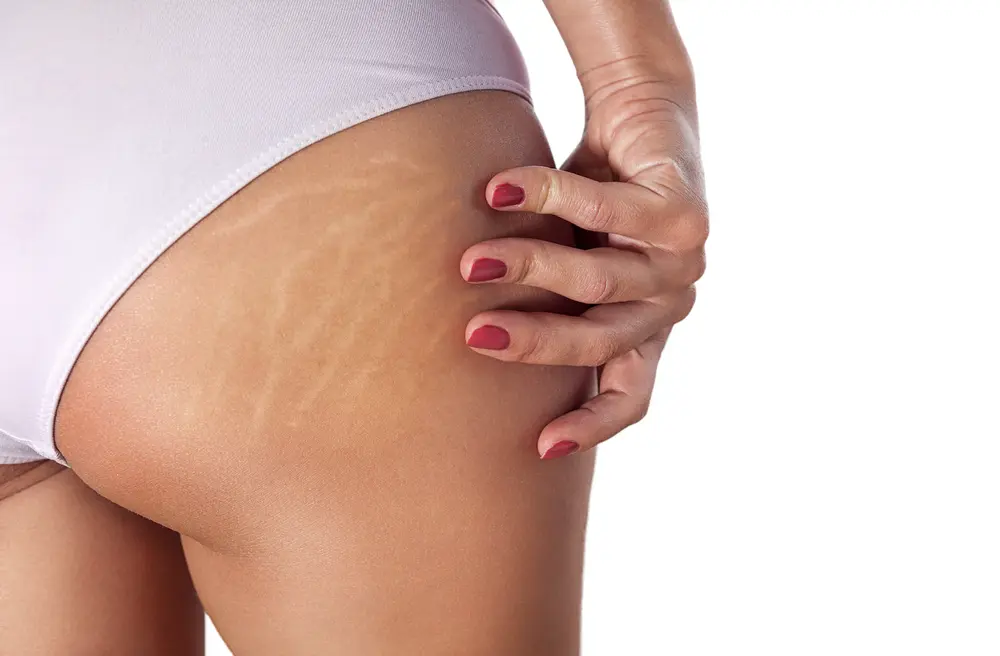
What stretch marks looks like?
Stretch marks, also known as striae, are usually red or whitish skin cracks that appear on certain parts of the body. These colorful lines on the skin are created when our skin expands or contracts rapidly. Some sudden changes in the body, such as weight gain, cause the skin to stretch, and this sudden change causes collagen and elastin to tear.
Collagen is a protein that helps to make the skin elastic and prevents the skin from sagging; If the skin does not have enough of this protein, it will crack due to the changes. In fact, these cracks are formed due to the reduction of skin elasticity and as a result of stretching due to sudden changes in weight, pregnancy or hormonal changes in the body.
Stretch marks, which are red or pink lesions, can occur anywhere on the body, but they are usually seen in areas of the body where the skin is thicker and large amounts of fat have been stored. The most common places are the flat stomach, chest, breasts, arms, underarms, waist, thighs (both inner and outer), pelvis and buttocks. Stretch marks may be brown to red in color and vary in height. This problem does not pose a risk to one’s health, but it may be considered a cosmetic problem.
Not everyone develops these narrow strips on their skin. Fluctuating hormone levels seem to play a role in this. Also, if people in your family have stretch marks, you may be at higher risk. In addition to weight gain, other factors such as pregnancy, breast implant surgery (prosthesis), bodybuilding, high levels of asteroids and Marfan syndrome, also cause stretch marks, which we will discuss further.
Types of stretch marks
Stretch marks are divided into two categories:
Colored cracks: Colored cracks (Striae Rubrae) are caused by excessive stretching of the skin in areas that have less elasticity. These cracks are initially red or purple in color and change to pink over time. These cracks are usually caused by sudden changes in weight, pregnancy, or hormonal changes in the body and are mostly seen in areas such as the abdomen, sides, chest, and thighs. Methods such as laser, microneedling or creams with vitamin E can be used to treat colored cracks.
Deep cracks: Deep cracks (Striae Distensae) are caused due to the breakage of skin fibers and as a result of the reduction of skin elasticity. These cracks are more common in areas where the skin is thinner, such as under the eyes, abdomen, thighs, knees, and chest, and are usually caused by excessive exercise, rapid growth during adolescence, or pregnancy. These cracks are red or purple at first and turn white over time. To treat deep cracks, you can use methods such as laser, microneedling, or creams with moisturizing and strengthening skin elasticity.
What is the cause of stretch marks?
Cracked skin in different parts of the body may occur due to various factors. Decrease in skin elasticity and as a result stretching due to sudden changes in body weight such as rapid fattening, losing too much weight or intense exercise can lead to stretching and breaking of skin fibers.
Pregnancy is also an important factor for skin cracking, because during this period, the skin in areas such as the abdomen, chest, thighs and arms is severely stretched. Hormonal changes can also reduce the elasticity of the skin and cause it to crack. These changes cause stretching of the skin and stretch marks are formed by increasing the elasticity, growth and eventually breaking of the skin fibers.
Although genetic factors, age, skin type, and lack of proper skin care can also play a role in causing stretch marks, sudden weight changes, pregnancy, and hormonal changes in the body are the main causes of stretch marks.
Usually, when nutrients do not reach the skin and their way is blocked in the blood vessels under the skin, stretch marks develop in different parts of the body. In addition to the aforementioned areas, these cracks are usually seen in places such as the lips, hands, stomach, and feet; But if they are not treated quickly, there is a possibility that other parts of the body will be affected by this complication.
When stretch marks first appear, they are red, purple, pink, reddish-brown, or dark brown, depending on your skin color. Early stretch marks may itch. Over time, the color fades and the thin strips sink under your skin.
Causes of stretch marks
1- Dry skin
Dry skin is the most common cause of cracked skin. In its natural and healthy state, the skin has some oil and moisture; But if the amount of these two natural substances in the body changes for any reason, the skin will be dry and eventually various cracks will appear on it. The causes of dry skin are:
- Cold
- chemicals
- medicines
- Excessive humidity
2- Eczema
Eczema is a skin disease that causes red and itchy skin. Although this disease can be seen in different parts of the body, it is more common in areas such as the face, hands, arms and back of the knees. In this condition, the dryness of the skin becomes so intense that cracking is clearly visible on the surface of the skin. Some of the symptoms of skin eczema include: peeling, blistering and severe itching.
3- Psoriasis
Psoriasis is a disorder of the immune system that causes skin cells to grow very quickly; But with the formation of extra cells, the peeling process begins.
4- Diabetic neuropathy
Cracked heels are a common complication of type 1 and type 2 diabetes. This disease can lead to diabetic neuropathy or nerve damage caused by diabetes. In this disease, the body’s nerves are not able to control the moisture of the skin, and dryness and cracking occur. Especially on the legs. Other symptoms of diabetic neuropathy include: numbness in the foot or hand, pain in the foot or hand, and weakness in the ankle.
5- Hormonal changes
Some stretch marks are not caused by dryness and loss of skin moisture. These types of cracks are usually caused by stretching of the skin and hormonal changes. Due to the difference in the type of structure and the reason for the formation of this type of crack, the name stria or stretch mark has been chosen for them.
6- Corticosteroid
Corticosteroids are a group of drugs used to reduce inflammation and tissue healing. Long-term use of corticosteroids on the skin can also cause stretch marks. If you have Cushing’s disease or Marfan syndrome, you may experience stretch marks.
In some cases, doctors may use corticosteroids to treat skin conditions such as eczema, psoriasis, and acne. However, long-term use of these drugs can lead to a decrease in the elasticity of the skin, resulting in the formation of stretch marks.
Some other causes of skin cracking
- Growth spurts that occur during puberty
- pregnancy
- Sudden weight change (rapid weight loss or gain)
- Weight training when you have rapid muscle growth
The cause of itchy skin cracks
Dry skin, hormone changes during pregnancy or hormonal treatment, skin inflammations, biological factors such as bacteria and fungi, sensitivity to chemicals, environmental factors or certain foods, some substances such as inappropriate clothing, detergents or chemicals, etc. can cause irritation. and inflammation of the skin.
To reduce the itching of stretch marks, you can use methods such as using moisturizers, using anti-inflammatory creams and lotions, using relaxing methods such as massage, and using anti-itching drugs and products.
The cause of cracking in different parts of the body separately+solutions
In addition to genetics, age, skin type, and lack of proper skin care, which may be the cause of skin tearing, in this section, we have tried to explain separately the reasons that cause stretch marks in different parts of the body.
The cause of back and body cracking
Cracks on the back and body usually occur due to sudden changes in body weight and severe stretching of the skin fibers in these areas. Skin fibers are stretched in these areas and break due to the reduction of skin elasticity, which results in the formation of skin cracks.
To reduce the risk of skin cracking in these areas, maintaining a healthy weight, using moisturizers, and proper skin care using methods such as massage and the use of oils can be helpful.
The cause of red stretch marks in teenagers
Red stretch marks in teenagers usually occur due to the sudden and rapid extension of the skin during growth and hormonal changes. During this period, teenagers experience rapid growth in their height and body weight, which causes stretching and stretching of the skin in different areas. Hormonal changes, especially the increase in sex hormones during this period, can also lead to a decrease in skin elasticity and the formation of red cracks.
Red stretch marks may turn white over time, but initial red stretch marks can remain on the skin. To reduce the risk of skin cracking in teenagers, proper skin care, use of moisturizers and avoidance of strenuous exercise can be helpful.
The cause of red cracks on the stomach
Abdominal stretch usually occurs due to sudden and rapid stretching of the skin in the abdominal area due to changes in body weight. Pregnancy and intense exercise may cause stretching and stretching of the skin in the abdominal area. In this process, the elasticity of the skin decreases and the skin fibers in this area are broken, which results in the formation of stretch marks in the abdomen.
To reduce the risk of stretch marks, maintaining a healthy weight, using moisturizers and skin care methods, such as massage and the use of oils, can be helpful. Also, consuming foods containing vitamin C and antioxidants can also help to improve skin health and reduce the risk of flatulence. The cause of leg groin cracking, buttock cracking usually occurs due to sudden extension and severe stretching of skin fibers in these areas.
The cause of sudden reddening of the abdominal skin
Sudden reddening of the abdominal skin can be caused by factors such as skin inflammation caused by infection, physical injury, skin sensitivity or contact with allergens, skin sensitivity to chemicals, foods or allergens, drug sensitivity, hormonal changes, environmental factors such as direct contact with the sun.
contact with irritating chemicals, changes in temperature or humidity can cause sudden reddening of the abdominal skin. If the redness of the abdominal skin is accompanied by other symptoms such as pain, itching, swelling, skin deformation or other symptoms, it is better to see a doctor to diagnose the exact cause and recommend the appropriate treatment.
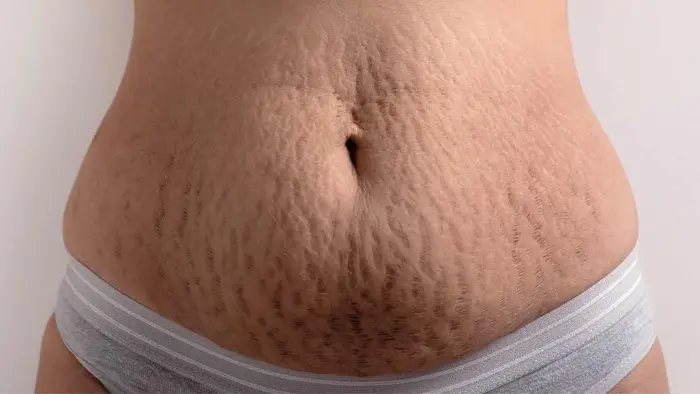
How to prevent abdominal distension during pregnancy?
- Using moisturizers and natural oils such as argan oil, olive oil or… can help maintain skin flexibility and elasticity.
- Weekly massage using moisturizer or oil can help improve blood flow and skin elasticity.
- Consuming healthy food rich in vitamin C and E, protein, essential fatty acid oils and water is very important to maintain healthy skin.
- Gaining too much weight during pregnancy may have a negative effect on the skin of the abdomen. Weight control and maintaining weight gain gradually and safely can prevent stretch marks.
The cause of cracking hands and feet
In addition to the above, daily activities, intense sports training, changes in body weight and carrying heavy objects can be factors that accelerate cracking of the skin of hands and feet.
To treat chapped hands or reduce the risk of chapped hands and feet, in addition to consuming foods containing vitamin C and antioxidants, using moisturizers, protecting the skin from external damage, such as using appropriate gloves and shoes, and proper skin care , such as massage and the use of oils, are recommended.
The cause of streaked skin
Streaking of the skin is usually due to an increase in the appearance of blood vessels and veins under the skin. Various factors can lead to veining of the skin. Including:
- Heredity: Some people experience veins in the skin due to heredity.
- Aging: With aging, the skin loses its collagen and elastin, which can make the skin thin and transparent, and more veins and vessels become visible.
- External factors: factors such as sunlight, smoking, alcohol and drug use can lead to the development of veins and veining of the skin.
- Hormonal changes: Hormonal changes, such as during pregnancy, perimenopause, and menopause, can cause veins to develop and the skin to become veiny.
- Weakness of blood vessels: Weakness of blood vessels can cause veins in the skin. Factors such as high blood pressure, diabetes and some vascular diseases can weaken the vessels and accelerate the veining of the skin.
The cause of back fat
The cause of oily back skin may be due to the following factors:
- Excessive activity of sebaceous glands: Sebaceous glands in the back skin secrete fat. If the sebaceous glands are too active, the amount of fat in the skin increases and causes the back skin to become oily.
- Excessive oil production: Some people may have excessive oil production in the back skin due to genetic or hormonal factors, which causes it to become oily.
- Hormonal changes: Hormonal changes may have an effect on back fat. Some factors such as changes in the menstrual period, pregnancy, the use of certain drugs or hormonal diseases can increase the production of fat and make the back skin greasy.
- Environmental factors: Environmental factors such as constant contact with fats, use of unhealthy products for the skin, use of unhealthy cosmetics and defects in proper skin care can lead to oily back skin.
Treatment of stretch marks, How to get rid of stretch marks?
Do you think there is a cure for stretch marks? The best way to get rid of stretch marks includes medical, home and traditional medicine methods, which we will briefly explain each method below.
Medical treatment of stretch marks
Can stretch marks be treated? We must say that yes, the ways to treat stretch marks and remove stretch marks medically include 6 basic methods:
Skin peeling:
A simple way to treat red stretch marks on the skin medically is by shaving or exfoliating the skin. In this method, dead skin cells are removed and the growth of new cells occurs. Chemical peels also have a similar effect and speed up the growth and repair of new skin by removing the dead layer of the skin surface. Of course, excessive use of these items may cause dry skin, so use a suitable moisturizing cream continuously.
Local treatments:
Using topical creams and ointments is also a cheap way to reduce the appearance of stretch marks. This treatment should be done regularly and continuously for a long time to be effective. In the treatment of body cracks with creams, the cracks are not completely removed, but their appearance is greatly reduced. Consult your doctor before using creams and ointments.
microderma:
This minimally invasive treatment is suitable for reducing the appearance of stretch marks. This treatment requires more than one visit to the doctor, and the number of appointments is determined by the doctor according to the type of stretch marks and its age and extent. In this treatment, the epidermis and the top layer of the skin are targeted, and as a result, the skin secretes collagen and the skin becomes tight and stretched.
In this treatment, dead cells are removed from the skin and after a few sessions, the appearance of stretch marks will be clearly visible. During this treatment, your skin may become dry and reddened due to shaving, but within 24 hours the skin will begin to heal and these symptoms will disappear.
Microneedling:
You can do microneedling to remove stretch marks. Microneedling targets the dermis layer of the skin, which is the middle layer of the skin and the place where stretch marks occur. During this treatment, they pierce the surface of the skin with small needles attached to the head of a device (dermaroll) to secrete collagen. These needles are microscopic and do not cause bleeding and only cause redness of the skin.
This treatment improves skin appearance and reduces stretch marks. For a better and complete treatment, you need more than one session at intervals of one month. If you have a calcium deficiency, we suggest you read the calcium deficiency symptoms article.
laser therapy:
Laser therapy is a common treatment for stretch marks. In this method, lasers penetrate the skin and cause regeneration. This method stimulates the tissues around the stretch marks to speed up their recovery. Laser therapy causes the stimulation of melanin, which is the pigment of the skin, in the place of laser treatment, and the pigment cells leaving the skin cause it to be the same color as other parts of the skin. Although this treatment is useful, it requires more than one session to produce significant results.
Cosmetic Surgery:
If other treatments are unsuccessful, cosmetic surgery can be used, which is relatively expensive. Surgery may cause stretch marks, but it is considered a definitive treatment for stretch marks and removes them permanently. Abdominoplasty is a surgical procedure that not only removes stretch marks, but also removes excess skin and fat. Due to this treatment, the skin becomes more stretched and looks firmer.
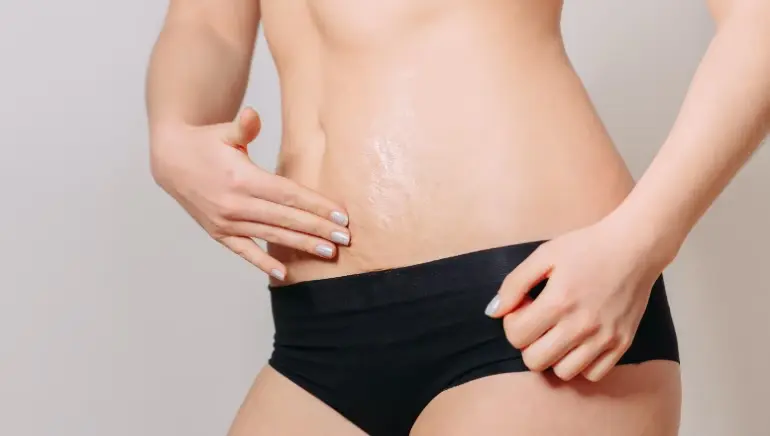
Home remedy for stretch marks
What to do to remove stretch marks at home? First of all, we must say that each skin and stretch mark may have its own needs, but usually, you can use the following methods to treat stretch marks at home:
- Natural oils: Using natural oils such as olive oil, coconut oil, and aloe vera oil can help nourish and moisturize the skin and improve the appearance of stretch marks.
- Moisturizing creams and lotions: Using moisturizing creams and lotions containing nutrients and vitamins can accelerate the improvement of the appearance of stretch marks and soften and soothe the skin.
- Massage: Regular massage using moisturizing oils can help improve blood flow and promote skin rejuvenation. By gently massaging the stretch marks, you can improve their appearance.
- Drink enough water: Make sure you drink enough water, as water can help keep skin hydrated and speed up the healing process of stretch marks.
- Healthy nutrition: appropriate and varied nutrition with the consumption of foods containing vitamins and nutrients can help improve skin health and repair stretch marks.
Treatment of stretch marks in traditional medicine
In addition to treatment with medical methods, it is also possible to treat stretch marks in traditional medicine. The methods of treating stretch marks in traditional medicine are:
Vitamin A:
Retinoid or vitamin A smoothes and rejuvenates the skin. This substance has been used in many skin creams. You can also use the tablets of this vitamin orally. Slimming diet and diet rich in foods such as carrots and sweet potatoes also increase the amount of this protein in the body.
Sugar:
Some people use sugar for exfoliation and microdermabrasion. In this method, mix some sugar with a softening liquid such as almond or coconut oil until it becomes wet sand; Then add a little lemon juice to it. Apply this substance on the skin. Use this method before the bath several times a week to get results.
Aloevera:
Natural aloe vera has a healing property that improves the appearance and cures stretch marks and softens the skin. You can use aloe vera daily after showering.
Hyaluronic acid:
Hyaluronic acid hydrates the skin and increases collagen in the skin, and maintains the shape and firmness of the skin after the reduction of collagen due to aging. Hyaluronic acid is also found in some products.
coconut oil:
Coconut oil heals cracks and regenerates the skin. This substance is considered completely safe if you are not allergic.
Centella:
Centella is a plant that is a popular ingredient in Korean beauty products. Products containing centella, known as cica cream, are sometimes used as a scar treatment or to help soothe and repair sensitive skin. Sika creams are growing in popularity in the United States, but they can be expensive.
Centella helps reduce inflammation and increase collagen production. Research conducted in 2015 suggests that creams containing centella may help prevent stretch marks during pregnancy and improve their appearance. But the researchers cautioned that more evidence is still needed.
Treatment of red stretch marks caused by obesity
The treatment of stretch marks caused by obesity may include methods and techniques such as the use of moisturizing creams and lotions containing nutrients and vitamins, the use of anti-stretch creams and gels containing substances such as retinol and hydroxyacetate, medical methods such as laser, microneedling, percollagen therapy and other methods.
Medicine to reduce redness, smooth texture, increase collagen production and improve the appearance of stretch marks, use of natural methods such as massage, use of natural oils (such as olive oil or jojoba oil), maintaining weight and eating healthy can be effective in improving stretch marks caused by obesity.
Treatment of abdominal pain with toothpaste
Using toothpaste to treat stretch marks may be effective in some cases, but note that this method is based on personal experience and may not work the same for everyone. Either way, you can follow these steps:
- Cleaning the target area: Before using the toothpaste, clean and dry the area of the abdominal cracks carefully with soap and water.
- Using toothpaste: Apply a thin layer of toothpaste on the cracks in the stomach. Make sure the toothpaste you use is free of unnecessary fragrances and additives.
- Massage: Using your fingers, gently massage the toothpaste on the abdominal cracks with soft circular movements. Massage helps improve blood flow and skin repair.
- Keeping the toothpaste: Leave the toothpaste on the skin until it dries and then wash it off with warm water. Finally, dry the skin.
Important note: It is important to remember that this treatment method is non-specialist and consider the most scientific and effective methods for treating abdominal cracks, including medical methods and the use of appropriate products, see a dermatologist.
Treatment of stretch marks and diet
For the treatment of any disease and complication, it is necessary to observe the diet and follow the basic guidelines because it makes the path to treatment easier and faster. So it is better to follow a diet that pays attention to all aspects and issues and considers a diet that works for us. We suggest that you go to the Serenity website and after reading the useful medical content of this website in the My Diet section, get your diet from a nutritionist.

